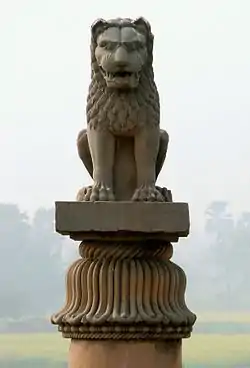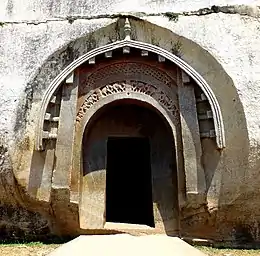Brihadratha Maurya
'Brihadratha (IAST: Brihadratha Maurya) was the last ruler of the Mauryan Empire. He ruled from 187 to 180 BCE, when he was killed by his general, Pushyamitra Shunga, who went on to establish the Shunga Empire. The Mauryan territories, centred on the capital of Pataliputra, had shrunk considerably from the time of Ashoka to when Brihadratha came to the throne.
| Brihadratha Maurya | |
|---|---|
| 9th Mauryan emperor | |
| Reign | c. 187 – c. 180 BCE |
| Predecessor | Shatadhanvan |
| Successor | Pushyamitra Sunga |
| Dynasty | Maurya Empire |
| Religion | Jainism |
| Maurya Empire (322–180 BCE) | ||||||||||||||||||||
|---|---|---|---|---|---|---|---|---|---|---|---|---|---|---|---|---|---|---|---|---|
|
||||||||||||||||||||
Reign
According to the Puranas, Brihadratha succeeded his father Shatadhanvan to the throne and ruled for seven years.[1]
Coup d'état by Pushyamitra Shunga
Brihadratha Maurya was killed in 180 BCE and power usurped by his general, Pushyamitra Shunga who then took over the throne and established the Shunga Empire.[2] Bāṇabhaṭṭa's Harshacharita says that Pushyamitra, while parading the entire Mauryan army before Brihadratha on the pretext of showing him the strength of the army, crushed his master.[3] Pushyamitra killed the former emperor in front of his military and established himself as the new ruler.
Invasion of Demetrius I
In 180 BCE, northwestern India (parts of modern-day Afghanistan and Pakistan) was occupied by the Greco-Bactrian king Demetrius (Dharmamita), followed by the overthrow of the Mauryan dynasty by the general Pushyamitra Shunga. The Mauryans had diplomatic alliances with the Greeks, and they may have been considered as allies by the Greco-Bactrians. A key detail is mentioned by Ceylonese Buddhist monk Badra, pointing that Brihadratha married Demetrius' daughter, Berenice (Suvarnnaksi in Pali texts).[4] The Greco-Bactrians may also have invaded India in order to protect Greek populations in the subcontinent. He established his rule in the Kabul Valley and parts of the Punjab region. Soon, however, they had to leave for Bactria to fight a fierce battle (probably between Eucratides I and Demetrius).[5]
The hypothesized Yavana invasion of Pataliputra is based in the Yuga Purana. Written in a prophetic, the a scripture describes the campaign of King Dharmamita:
- Then, having approached Saketa, together with Panchala and the Mathuras, the Yavanas (Indo-Greeks), wicked and valiant, will reach Kusumadhvaja ("The town of the flower-standard", Pataliputra).
- Then, once Puspapura (Pataliputra) has been reached, [and] its celebrated mud[-walls] cast down, all the realms will be in disorder, there is no doubt.
- There will then finally be a great war, of wooden weapons, and there will be the vilest of men, dishonourable and unrighteous.
References
Citations
- Thapar, Romila (1998). Aśoka and the decline of the Mauryas : with new afterword, bibliography and index (2nd ed.). Delhi: Oxford University Press. p. 183. ISBN 0-19-564445-X.
- Thapar 2013, p. 296.
- Lahiri, B. (1974). Indigenous States of Northern India (Circa 200 B.C. to 320 A.D.) , Calcutta: University of Calcutta, pp.24-5
- S. Paranavithana. The Greeks and the Mauryas, 1971. https://archive.org/details/thegreeksandthemauryassenartparanavitana1971_104_N
- Lahiri, B. (1974). Indigenous States of Northern India (Circa 200 B.C. to 320 A.D.) , Calcutta: University of Calcutta, pp.22-4
- The Yuga Purana. Translated by Mitchiner, John E. Calcutta: The Asiatic Society. 1986. p. 91.
- The Sungas, Kanvas, Republican Kingdoms and Monarchies, Mahameghavahanas, Dilip Kumar Chakrabarti, p.6
Sources
- Thapar, Romila (2013), The Past Before Us, Harvard University Press, ISBN 978-0-674-72651-2
Brihadratha Maurya | ||
| Preceded by Shatadhanvan |
Maurya Emperor 187–185 |
Succeeded by Pushyamitra (Shunga Empire) |
| Succeeded by Demetrius I (Indo-Greek Kingdom) | ||

